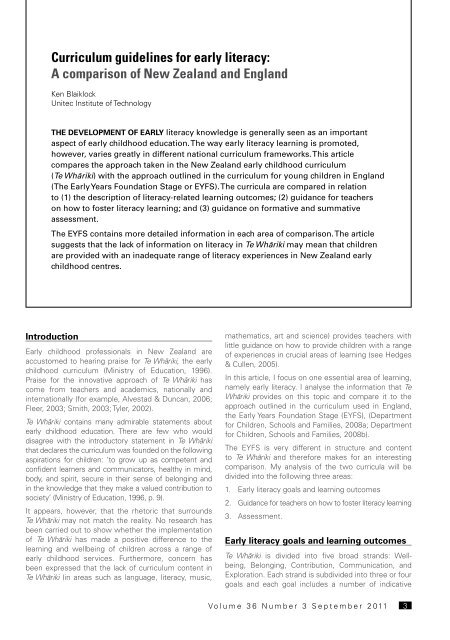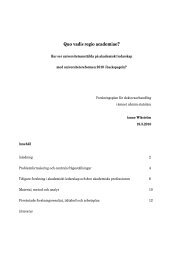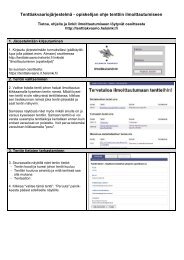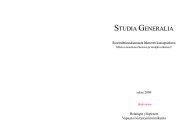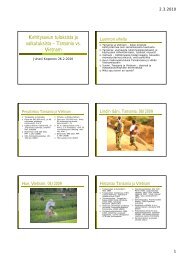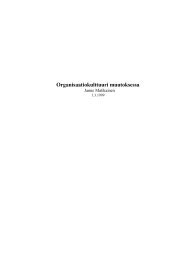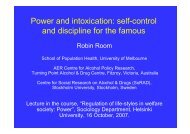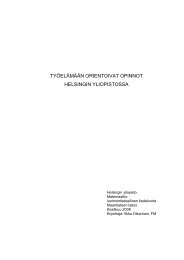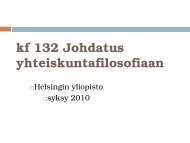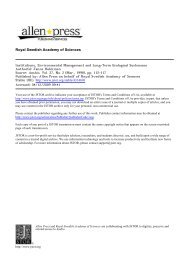EditorialSometimes I reflect on how vulnerable we areto changes in policies and changes in government. Iremember the frenzy in the Australian early childhoodcommunity at the time <strong>of</strong> the latest federal election aswe all tried to create space on the political agenda foryoung children and their families. I reflect on electionsin the past and the cycles <strong>of</strong> policy changes I haveexperienced over my time in early childhood. I rememberrestructuring degree courses based on my expectations <strong>of</strong>outcomes from government policy changes. McLachlansummarises this for us in the New Zealand context andpoints out the shifts in early childhood policy arising fromthe new government, their stronger focus on targetedservices rather than universal, and their withdrawal <strong>of</strong>funds from a number <strong>of</strong> early childhood initiatives thathad garnered New Zealand a leading reputation in earlychildhood over past years. And in reading this article,I wonder what this might presage for the rest <strong>of</strong> us inAustralasia. Will we see similar moves?Part <strong>of</strong> the political arena is the space we create (or don’tcreate) for children to participate in the decisions thatimpact upon them. Theobald, Danby and Ailwoodreview policy and research in Australia and identifya growing commitment for children’s participationcoupled with an ongoing challenge to translate this intodaily practice. Greenfield proposes one way this canbe addressed in research, using a mosaic approach t<strong>of</strong>acilitate children’s voice.Irrespective <strong>of</strong> the political agenda, we want to focus onexcellence in service delivery and the remainder <strong>of</strong> ourarticles in this issue do just that. A number <strong>of</strong> researchersreport work they are doing in specific areas <strong>of</strong> the earlychildhood curriculum. Stagnitti, Kenna, Malakellis,Kershaw, Hoare and de Silva-Sanigorski discuss theirintervention focusing on fundamental movement skillsfor children from disadvantaged backgrounds. Blaiklockundertakes a comparison <strong>of</strong> the UK <strong>Early</strong> Years FoundationStage and Te Whāriki in New Zealand, focusing particularlyon how these documents promote early literacy, and theimplications for this on local practice. McDonough andSullivan address learning to measure length in the firstthree years at school, using data from the 70 schools in theVictorian <strong>Early</strong> Numeracy Research Project. Howitt, Lewisand Upson take us on a forensic science experiencewith young children, demonstrating young children’scompetency in an area we <strong>of</strong>ten think as being associatedwith older children. They argue that such experiencesnot only impact on children’s science thinking but onimagination and oral language as well. Mills also makesthe point that experiences have multiple outcomes. Sheaddresses transmediation, the process <strong>of</strong> transferringinformation from one sign-system to another and arguesthat such experiences support generative thinking.Sajaniemi, Suhonen and myself investigate some <strong>of</strong> thebiological underpinnings impacting on children’s learningand propose a model linking children’s regulation <strong>of</strong> arousal,the synchronicity <strong>of</strong> the underpinning biology and children’slearning outcomes.In following the curriculum focus, the next two articlesaddress issues related to pre-service teacher education.Yim and Ebbeck discuss pre-service teachers and musiceducation, comparing experiences and perceptions <strong>of</strong>music between students in South Australia and thosein Hong Kong. Garvis focuses on arts education anddemonstrate links between experiences on placementrelated to arts and students’ self-efficacy in arts education.Nolan and Sim focus on reflection, a key skill in improvingpractice and one used in many teacher education programs.They argue that reflection needs a structure or frameworkin order to be effective.Many <strong>of</strong> the papers in this issue focus on young childrenin the context <strong>of</strong> early childhood programs—children inclasses or groups. Millar looks at the transition <strong>of</strong> Koreanchildren from the home environment into classes injunior primary and identifies the importance <strong>of</strong> languageand relationships in facilitating successful transitions.Jackiewicz, Saggers and Frances discuss issues <strong>of</strong>access and barriers to participation for Indigenous childrenparticipating in early childhood programs. They identifyfour key issues: accessibility, affordability, acceptability andappropriateness.Finally we <strong>of</strong>fer two papers that address issues outside <strong>of</strong>the classroom; issues relating to young children and theirfamilies. Ford <strong>of</strong>fers an evaluation <strong>of</strong> a program designedto support parents who experience difficulties related totheir infants’ sleep. George, Vickers, Wilkes and Bartonanalyse the cost <strong>of</strong> caring for a child with chronic illness forparents who are working full time. These parents are <strong>of</strong>tennot eligible to receive additional supports because they areworking, but are faced with the prospect <strong>of</strong> lower-paid jobs(in a trade-<strong>of</strong>f for flexibility) and higher costs associated withtheir child’s needs.As we progress through 2011 and the world changesaround us, we also reflect on the changes in the earlychildhood landscape. Every day we learn more about qualityearly childhood service provision, and every day we striveto deliver the best we can to our children, their families andour students. Enjoy reading these articles and reflecting onwhat they mean for your practice.Margaret SimsUniversity <strong>of</strong> New England2A u s t r a l a s i a n J o u r n a l o f E a r l y C h i l d h o o d
Curriculum guidelines for early literacy:A comparison <strong>of</strong> New Zealand and EnglandKen BlaiklockUnitec Institute <strong>of</strong> TechnologyThe development <strong>of</strong> early literacy knowledge is generally seen as an importantaspect <strong>of</strong> early childhood education. The way early literacy learning is promoted,however, varies greatly in different national curriculum frameworks. This articlecompares the approach taken in the New Zealand early childhood curriculum(Te Whāriki) with the approach outlined in the curriculum for young children in England(The <strong>Early</strong> Years Foundation Stage or EYFS). The curricula are compared in relationto (1) the description <strong>of</strong> literacy-related learning outcomes; (2) guidance for teacherson how to foster literacy learning; and (3) guidance on formative and summativeassessment.The EYFS contains more detailed information in each area <strong>of</strong> comparison. The articlesuggests that the lack <strong>of</strong> information on literacy in Te Whāriki may mean that childrenare provided with an inadequate range <strong>of</strong> literacy experiences in New Zealand earlychildhood centres.Introduction<strong>Early</strong> childhood pr<strong>of</strong>essionals in New Zealand areaccustomed to hearing praise for Te Whāriki, the earlychildhood curriculum (Ministry <strong>of</strong> Education, 1996).Praise for the innovative approach <strong>of</strong> Te Whāriki hascome from teachers and academics, nationally andinternationally (for example, Alvestad & Duncan, 2006;Fleer, 2003; Smith, 2003; Tyler, 2002).Te Whāriki contains many admirable statements aboutearly childhood education. There are few who woulddisagree with the introductory statement in Te Whārikithat declares the curriculum was founded on the followingaspirations for children: ‘to grow up as competent andconfident learners and communicators, healthy in mind,body, and spirit, secure in their sense <strong>of</strong> belonging andin the knowledge that they make a valued contribution tosociety’ (Ministry <strong>of</strong> Education, 1996, p. 9).It appears, however, that the rhetoric that surroundsTe Whāriki may not match the reality. No research hasbeen carried out to show whether the implementation<strong>of</strong> Te Whāriki has made a positive difference to thelearning and wellbeing <strong>of</strong> children across a range <strong>of</strong>early childhood services. Furthermore, concern hasbeen expressed that the lack <strong>of</strong> curriculum content inTe Whāriki (in areas such as language, literacy, music,mathematics, art and science) provides teachers withlittle guidance on how to provide children with a range<strong>of</strong> experiences in crucial areas <strong>of</strong> learning (see Hedges& Cullen, 2005).In this article, I focus on one essential area <strong>of</strong> learning,namely early literacy. I analyse the information that TeWhāriki provides on this topic and compare it to theapproach outlined in the curriculum used in England,the <strong>Early</strong> Years Foundation Stage (EYFS), (Departmentfor Children, Schools and Families, 2008a; Departmentfor Children, Schools and Families, 2008b).The EYFS is very different in structure and contentto Te Whāriki and therefore makes for an interestingcomparison. My analysis <strong>of</strong> the two curricula will bedivided into the following three areas:1. <strong>Early</strong> literacy goals and learning outcomes2. Guidance for teachers on how to foster literacy learning3. Assessment.<strong>Early</strong> literacy goals and learning outcomesTe Whāriki is divided into five broad strands: Wellbeing,Belonging, Contribution, Communication, andExploration. Each strand is subdivided into three or fourgoals and each goal includes a number <strong>of</strong> indicativeVo l u m e 3 6 N u m b e r 3 S e p t e m b e r 2 011 3
- Page 3 and 4: 1.5 Display, download or print the
- Page 5: Volume 36 Number 3 September 2011Jo
- Page 9 and 10: ■■Know that print carries meani
- Page 14 and 15: Korean children’s cultural adjust
- Page 16 and 17: The Early Years Learning Framework
- Page 18: Kyung Min said listening in class w
- Page 21 and 22: immediately impact on children’s
- Page 23 and 24: Child participation in the early ye
- Page 25 and 26: their kindergarten day. A study by
- Page 27 and 28: the overall organisation, routines,
- Page 29 and 30: Council of Australian Governments (
- Page 31: Learning to measure length in the f
- Page 34 and 35: ■■a 40-minute, one-on-one inter
- Page 36 and 37: ■■72 per cent of the project sc
- Page 38 and 39: In other words, the difficulties th
- Page 40 and 41: An analysis of New Zealand’s chan
- Page 42 and 43: Before five also gave equivalent st
- Page 44 and 45: some evidence that curriculum effec
- Page 46 and 47: achievement; aiding transition to s
- Page 49 and 50: ‘It’s a mystery!’A case study
- Page 51: analysis of discourse the children
- Page 56 and 57:
ange of objects on the floor (such
- Page 58 and 59:
Observation and recording informati
- Page 60 and 61:
‘I’m making it different to the
- Page 62 and 63:
Purpose and theoretical frameworkIn
- Page 64 and 65:
The fingers were reaching out acros
- Page 66 and 67:
Figure 7. ‘I take this lovely lad
- Page 68 and 69:
Here, Rachel used substitution to r
- Page 70:
Evaluating the feasibility, effecti
- Page 73 and 74:
Table 2. Descriptive characteristic
- Page 75 and 76:
The children in this study were fro
- Page 77 and 78:
Vol. 36 No. 3 September 2011Austral
- Page 79 and 80:
implement the curriculum effectivel
- Page 81 and 82:
Table 2. Mean differences between H
- Page 83 and 84:
can be regarded as one of the infor
- Page 85 and 86:
Ganser, T. (2000). An ambitious vis
- Page 87 and 88:
(Buckhalt et al., 2009). Reduced qu
- Page 89 and 90:
invited families having difficulty
- Page 91 and 92:
Table 3. Mean hours of mother and f
- Page 93 and 94:
A reduction in night wakings might
- Page 95 and 96:
A preliminary exploration of childr
- Page 97 and 98:
adult support necessary for its eff
- Page 99 and 100:
Children’s cortisol and alpha-amy
- Page 102 and 103:
Connor, C., Son, S.-H., Hindman, A.
- Page 104 and 105:
Equity of access:Requirements of In
- Page 106 and 107:
excursions, which have been reporte
- Page 108 and 109:
We need a bus but we also need a st
- Page 110 and 111:
Appropriate child careIndigenous fa
- Page 112 and 113:
Australian Institute of Health and
- Page 114 and 115:
The Mosaic Approach relies on child
- Page 116 and 117:
participants (Altrichter, Posch, &
- Page 118 and 119:
distance. This involved trying to b
- Page 120 and 121:
Dockett, S., & Perry, B. (2003). Ch
- Page 122 and 123:
experiences (Bandura, 1997). Belief
- Page 124 and 125:
the curriculum while on their profe
- Page 126 and 127:
Exploring and evaluating levels of
- Page 128 and 129:
Level 2: Attending to feelingsThis
- Page 130 and 131:
This process to ensure coder stabil
- Page 132 and 133:
DiscussionStructured reflective pro
- Page 134 and 135:
Rock, T. C., & Levin, B. B. (2002).
- Page 136 and 137:
issues encountered in their caring
- Page 138 and 139:
pertaining to the impact and suppor
- Page 140 and 141:
Parents felt the policies involving
- Page 142 and 143:
and access suitable carers because
- Page 144 and 145:
Ievers, C. E., & Drotar, D. (1996).
- Page 146:
www.earlychildhoodaustralia.org.auE


